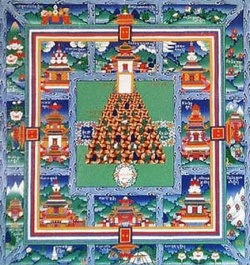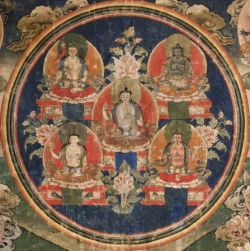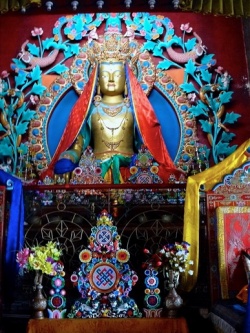The Earliest Evidence of Bonpo Rituals?
The four-sided, pointed stick pictured above was found in the desert fortress of Miran by Aurel Stein in 1907. Along with the most of Stein’s acquisitions, it was then sent to London, where it was placed in the India Office Library, to be ignored by almost everyone except the librarian FW Thomas, who attempted to read the Tibetan writing on all of its four sides, and published his translation in his Tibetan Literary Texts and Documents in the 1950s.
The stick is all that remains of a ritual performance, which is recorded in Tibetan writing on each of its four sides. The writing tells us that this was a ritual for a local deity (yul lha) carried out by a team of ritual specialists including a bon po. Like the other documents from Miran, it dates from the time when the fort was an outpost of the Tibetan empire, which began to fall apart in the middle of the 9th century. This stick probably dates from a few years (perhaps a few decades) before that collapse.
So what we have seems to be a record of the actual performance of a ritual dating back to the time of the Tibetan empire. I think this must be by far the earliest reliable documentary evidence of the actual ritual activities of people identifying themselves as bon po.
Why is this interesting? There has been a debate going on in Tibetological circles for some time about the early non-Buddhist Tibetan religion, which was probably not known as Bon but was practised by ritualists known as bon po. The relationship between this early complex of ritual practices and the religion known as Bonpo (now accepted as one of the schools of Tibetan Buddhism) is complicated. Modern scholarship has cast doubt on the accounts of the Bonpo tradition about its own history, transmitted in texts which generally date from after the 10th century. Those attempting to understand the nature of the early non-Buddhist Tibetan religion have often turned to the Dunhuang manuscripts as an alternative source of evidence (I wrote more about this a while ago in this post).
There are quite a few manuscripts from Dunhuang about non-Buddhist ritual practices like funerals, divination and healing. I could write much more about them, but to show why the wooden dockets from Miran are so interesting, I’ll just say why the Dunhuang sources are somewhat unsatisfactory. First, as the Dunhuang cave seems to have been sealed in the early 11th century, these manuscripts may not date from much earlier than the transmitted texts of the Bonpo tradition, weakening claims by scholars that they are the more authentic sources. Second, the Dunhuang manuscripts are literary sources (though probably derived from oral traditions), mostly narratives or paradigms which would have presumably have supported ritual practice, but are not evidence for what people were actually doing.
On the other hand, the dockets from Miran can be dated, with some confidence, to the 9th century, and probably to Tibet’s imperial era. As records of actual ritual events, they let us know that this was not a merely a literary tradition, but a living practice. And unlike the literary texts, they are firmly local, telling us who the officiants of the ritual were, why the ritual was carried out, and the local deities to whom the ritual was addressed. The offer us the chance to see the activities of the bon po (as well as other ritual officiants like gshen), “on the ground.”
So, what kinds of rituals were being performed for the Tibetan military officials of the Miran fort? Unsurprisingly, there are quite a few records of funerals (see for example IOL Tib N 330). It is difficult to work out exactly what happened in the course of these rituals (despite Thomas’s valiant attempts at translation). It looks to me like the main aim of the funeral was to guide the “mental principle” (thugs) of the deceased to the right level (gral). One of the practices accompanying this seems to be a libation offering: most of the funeral records specify a precise number of spoonfuls (yams) of a sacred beverage (skyems) to be offered. Reference to a “beverage offering” (skyems gsol) in the Old Tibetan Annals suggests that some form of this practice goes back to the 7th century or earlier.
But it is only in another kind of ritual, the supplication of local deities, that we find the four-sided pointed sticks like the one at the top of this post. I don’t know the reason for the stick’s being carved into this shape, and any ideas would be welcomed (could it represent an arrow, for example?). The ritual supplications are directed to a variety of deities, including the local deities (yul lha), and minor spirits like sman and g.yang. In these rituals, the main officiant is called lha bon po, that term lha presumably indicating his special role towards deities. The other officiant is the gshen, and it is interesting to see that it was the norm, rather than the exception, for these two types of ritualist to work together.
There’s much more to be said about these ritual dockets, but I’ll conclude with a thought about the people who produced them. Clearly they were the soldiers and officials manning the outposts of the Tibetan empire in [[Wikipedia:Central Asia|Central Asia]]. In two cases, we have the names of the people who either officiated or commissioned the ritual, and they both have the high official rank of blon. So it seems that well after the official adoption of Buddhism as the Tibetan state religion, the practice of non-Buddhist rituals was common (perhaps even standard) among the Tibetan ruling class. In a sense, this shouldn’t surprise us. Perhaps more surprising is that one of the dockets (IOL Tib N 279) mentions the presence of 21 Buddhist monks (dge ‘dun) at a funeral ritual. It is difficult to say from this source whether these monks were carrying out the role normally performed by the bon po or were just in attendance at a (non-Buddhist) funeral for a deceased member of their sangha. Either scenario is intriguing.
References
I have written an article on these and other early sources on non-Buddhist Tibetan ritual practice, provisionally titled “The Naming of Tibetan Religion: Bon and Chos in the Imperial Period,”which will come out at some point in the near-ish future, and I’ll post a notification when it does.
FW Thomas’s translations can be found in the section “Government and Social Conditions” of his Tibetan Literary Texts and Documents concerning Chinese Turkestan, Part II: Documents, Royal Asiatic Society, London, 1951.
For some interesting discussion of the term bon in the early period, and the dates of the Dunhuang sources, see Henk Blezer, “Ston pa gshen rab: Six Marriages and Many More Funerals.” Revue d’Études Tibétaines 15 (2008): 421–479. PDF available right here.
The reference to skyems gsol in the Old Tibetan Annals is in the year 682-3. See the translation at p.94 of Brandon Dotson’s The Old Tibetan Annals: An Annotated Translation of Tibet’s First History. Vienna: Verlag der Österreichischen Akademie der Wissenschaften, 2009. The Tibetan text of the Annals and many early ritual texts from Dunhuang are freely available over at OTDO.
I also recommend having a look at Vincent Bellezza’s translation of a narrative on the “golden libation” (gser skems) recently found in the Gathang stupa.



